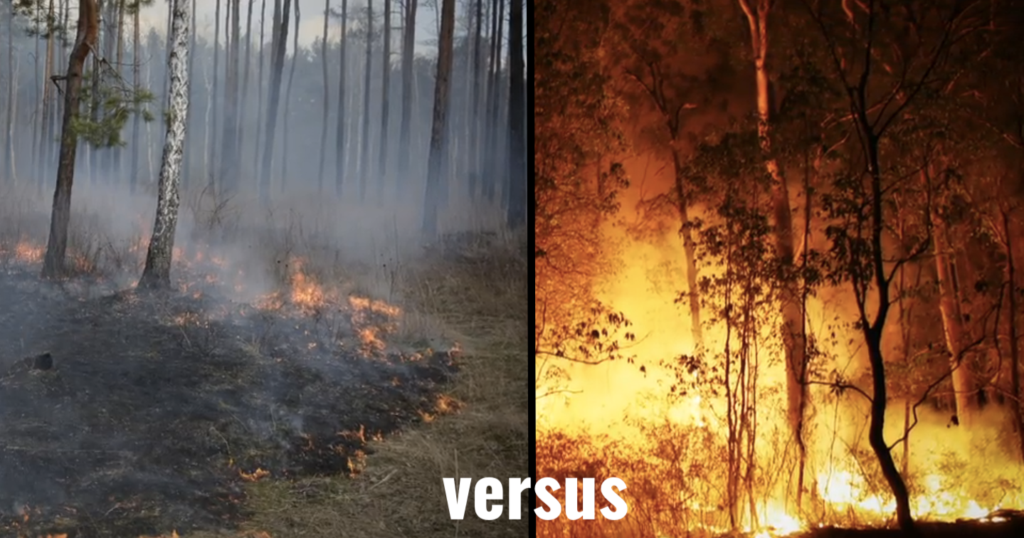
Firestick
Tink has been following the fires in Australia quite closely. I have a harder time, I reach emotional saturation and want to turn away from it. This morning, I was jolted awake by the picture to the right. All I could think about is what it must have sounded like on that abandoned street.
My way of processing the horror of what’s happening in Australia is to try and tell the story of these modern fires from a historical perspective of land management. I mean no disrespect to my sisters and brothers currently struggling with the reality of these fires. If we can understand the root causes, I see the possibility of individual agency and collective action.
The beginning is a bit slow, I hope you’ll bear with me for a few paragraphs.
One way to divide the world is between brittle and humid climates.
Humid climates, like much of New Zealand and Europe, have rainfall throughout the year. There is a wetter season and a drier season, but there is enough moisture for plants and microbes1 to stay active for most of the year. Without human intervention, these climates generally end up as woodlands.
Brittle climates, like much of Australia, North America and Africa, have distinct wet and dry seasons. A short, intense rainy season and a long dry season. During the dry season, plants and microbes go dormant due to the lack of moisture. Without human intervention, these climates generally end up as grasslands.
One of the ways that microbes increase soil fertility is by breaking down plant material and returning nutrients to the soil. If microbes are dormant (or absent) nutrients are released into the atmosphere rather than returned to the soil.2 The more nutrients end up in the atmosphere, the less fertile the soil becomes. As fertility declines, so does the quantity and quality of life which the ecosystem can support.
Brittle climate grasslands co-evolved with grazing herbivores. The cooperation between grass and herbivores created some of the richest and deepest soils in the world. Grazing herbivores use the microbes and moisture in their digestive system to breakdown plant material. Grazing means that even during the dry season, nutrients can still be returned to the soil as manure rather than lost to the atmosphere.
One of the crucial distinctions between brittle and humid climates is the land’s response to rest.3 Resting land in a humid climate increases soil fertility and ecological health.4 Resting land in a brittle climate decreases fertility and ecological health.
Our earliest ancestor, Homo erectus, appeared on the brittle African savanna.5 They spent two million years hunting and foraging the savannas of Africa and southern Asia.6 Roaming these grasslands were large herds of grazing megafauna. As humans began to spread across the world about 50,000 years ago, the extinction of megafauna followed. Only in Africa and southern Asia, where we co-evolved with them, does wild megafauna continue to exist.7
Without megafauna, there was a shortage of grazing animals to consume plant material during the dry season. As fuel loads increased, so too did the number of wildfires. The fertility of the land began to decline. Indigenous cultures of the world recognised this and began to use fire to breakdown plant material. Fire is a poor substitute for grazing as many nutrients are lost to the atmosphere, but some nutrients return to the soil as ash. Over centuries, the people who lived in brittle climates developed knowledge and practices of how to use fire to preserve the fertility of the land they relied on.
Five hundred years ago, Europeans began to spread over the world. With them came the knowledge and practices of managing the humid environments of Northern Europe. Their inexperience with brittle climates, and unwillingness to listen to indigenous knowledge, has caused widespread ecological degradation. In particular, the assumption that rest was a way of restoring fertility meant that they didn’t understand how indigenous fire practices were being used to create ecological health.
For centuries, indigenous practices of fire have been suppressed. Without grazing animals or the skilled use of fire, these landscapes have been steadily accumulating fuel loads. The higher the fuel load, the bigger and hotter the fires. Hotter fires mean greater destruction of habitat for microbes, plants, animals, and humans. This is what we’re now watching unfold in California and Australia.
The bad news is that these fires are explicitly the result of poor human management.
The good news is that human management is the one thing we can directly control. We have to get over our prejudice against fire and grazing animals. We have to step back into our traditional role as stewards of the land. We have to remember how to act in a way that benefits all life.
Once upon a time, every human culture knew how to do this. We can learn to do it again.
Loading comments...